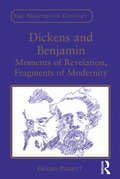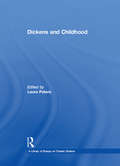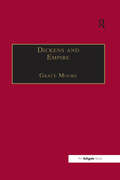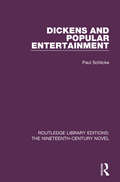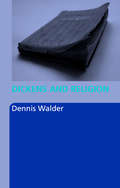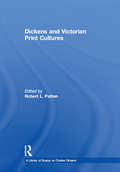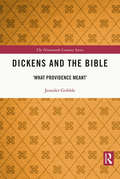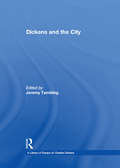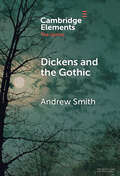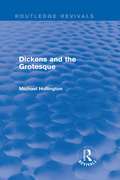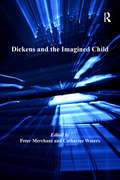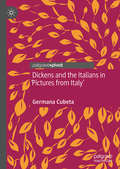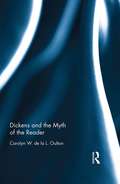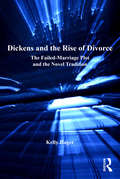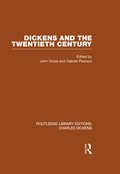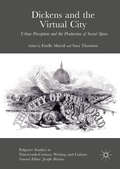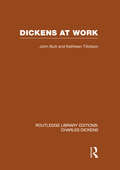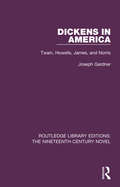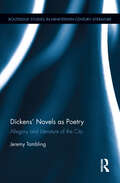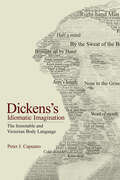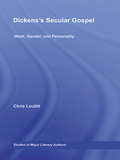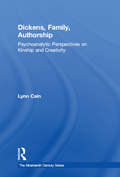- Table View
- List View
Dickens Dictionary: An A-Z of England's Greatest Novelist
by John SutherlandFROM THE BOOK JACKET: For fans old and new, this is a fascinating tour through Charles Dickens's novels, in the hands of a master critic and -- interpreter of his work. Oliver Twist... Great Expectations... David Copperfield - all contain riotous fictional worlds that still live and breathe for readers today. But how much do we really know about the dazzling imagination that brought them all into being? To celebrate the bicentenary of the birth of Dickens in 2012, Victorian literature expert John Sutherland has created a gloriously wide-ranging alphabetical companion to Dickens's novels, excavating the hidden links between his characters, themes, and preoccupations, and the minutiae of his endlessly inventive wordplay.
Dickens and Benjamin: Moments of Revelation, Fragments of Modernity (The\nineteenth Century Ser.)
by Gillian PiggottPlacing the works of Charles Dickens and Walter Benjamin in conversation with one another, Gillian Piggott argues that the two writers display a shared vision of modernity. Her analysis of their works shows that both writers demonstrate a decreased confidence in the capacity to experience truth or religious meaning in an increasingly materialist world and that both occupy similar positions towards urban modernity and its effect upon experience. Piggott juxtaposes her exploration of Benjamin's ideas on allegory and messianism with an examination of Dickens's The Old Curiosity Shop, arguing that both writers proffer a melancholy vision of a world devoid of space and time for religious experience, a state of affairs they associate with the onset of industrial capitalism. In Benjamin's The Arcades Project and Dickens's Sketches by Boz and Tale of Two Cities, among other works, the authors converge in their hugely influential treatments of the city as a site of perambulation, creativity, memory, and autobiography. At the same time, both authors relate to the vertiginous, mutable, fast-paced nature of city life as involving a concomitant change in the structure of experience, an alteration that can be understood as a reduction in the capacity to experience fully. Piggott's persuasive analyses enable a reading of Dickens as part of a European, particularly a German, tradition of thinkers and writers of industrialization and modernity. For both Dickens and Benjamin, truth appears only in moments of revelation, in fragments of modernity.
Dickens and Childhood (A Library of Essays on Charles Dickens)
by Laura Peters'No words can express the secret agony of my soul'. Dickens's tantalising hint alluding to his time at Warren's Blacking Factory remains a gnomic statement until Forster's biography after Dickens's death. Such a revelation partly explains the dominance of biography in early Dickens criticism; Dickens's own childhood was understood to provide the material for his writing, particularly his representation of the child and childhood. Yet childhood in Dickens continues to generate a significant level of critical interest. This volume of essays traces the shifting importance given to childhood in Dickens criticism. The essays consider a range of subjects such as the Romantic child, the child and the family, and the child as a vehicle for social criticism, as well as current issues such as empire, race and difference, and death. Written by leading researchers and educators, this selection of previously published articles and book chapters is representative of key developments in this field. Given the perennial importance of the child in Dickens this volume is an indispensable reference work for Dickens specialists and aficionados alike.
Dickens and Empire: Discourses of Class, Race and Colonialism in the Works of Charles Dickens (The Nineteenth Century Series)
by Grace MooreDickens and Empire offers a reevaluation of Charles Dickens's imaginative engagement with the British Empire throughout his career. Employing postcolonial theory alongside readings of Dickens's novels, journalism and personal correspondence, it explores his engagement with Britain's imperial holdings as imaginative spaces onto which he offloaded a number of pressing domestic and personal problems, thus creating an entangled discourse between race and class. Drawing upon a wealth of primary material, it offers a radical reassessment of the writer's stance on racial matters. In the past Dickens has been dismissed as a dogged and sustained racist from the 1850s until the end of his life; but here author Grace Moore reappraises The Noble Savage, previously regarded as a racist tract. Examining it side by side with a series of articles by Lord Denman in The Chronicle, which condemned the staunch abolitionist Dickens as a supporter of slavery, Moore reveals that the tract is actually an ironical riposte. This finding facilitates a review and reassessment of Dickens's controversial outbursts during the Sepoy Rebellion of 1857, and demonstrates that his views on racial matters were a good deal more complex than previous critics have suggested. Moore's analysis of a number of pre- and post-Mutiny articles calling for reform in India shows that Dickens, as their publisher, would at least have been aware of the grievances of the Indian people, and his journal's sympathy toward them is at odds with his vitriolic responses to the insurrection. This first sustained analysis of Dickens and his often problematic relationship to the British Empire provides fresh readings of a number of Dickens texts, in particular A Tale of Two Cities. The work also presents a more complicated but balanced view of one of the most famous figures in Victorian literature.
Dickens and Popular Entertainment (Routledge Library Editions: The Nineteenth-Century Novel #34)
by Paul SchlickeFirst published in 1985. Dickens was a vigorous champion of the right of all men and women to carefree amusements and dedicated himself to the creation of imaginative pleasure. This book represents the first extended study of this vital aspect of Dickens’ life and work, exploring how he channelled his love of entertainment into his artistry. This study offers a challenging reassessment of Nicholas Nickleby, The Old Curiosity Shop and Hard Times. It shows the importance of entertainment to Dickens’ journalism and presents an illuminating perspective on the public readings which dominated the last twelve years of his life. This book will be of interest to students of literature.
Dickens and Religion
by Dennis WalderThe importance of understanding Dickens's religion to obtain a full appreciation of his achievement has long been admitted; but this is the first critical study of the interaction between Dickens's religious beliefs and his creative imagination throughout his career. The novelist's religious beliefs are a pervasive and deeply felt presence in his works even if they are not always clearly thought out or expressed. Too discreet and humane to be as explicit, or as dull, as most of the professedly religious novelists of his time, Dickens nevertheless suggests in his own way a liberal Protestant belief, shot through with Romantic, transcendental yearnings, which undoubtedly appealed to a very wide range of readers. Dickens's religion is shown to be that of a great popular writer, who created a unique kind of fiction, and a unique relationship with his readers, by the absorption and transformation of less respectable contemporary forms, from fairy-tale and German romance to tract and print. Walder's thoroughly researched and lively book provides students of Dickens and the Victorian period with an original perspective on the novelist's methods and attitudes. He offers a judicious and informed exploration of Dickens's obsessive themes, from the 'fall' of innocence in Pickwick Papers, to the search for a religious 'answer' in Little Dorrit. Each chapter focuses upon the striking congruences revealed between individual novels, or groups of novels, and particular religious themes. The views expressed in Dickens's lesser fiction and non-fiction are drawn on throughout, as are those in the influential contemporary press.
Dickens and Victorian Print Cultures (A Library of Essays on Charles Dickens)
by Robert L. PattenThis volume places Dickens at the centre of a dynamic and expanding Victorian print world and tells the story of his career against a background of options available to him. The collection describes a world animated by outpourings of print materials: books, serials, newspapers, periodicals, libraries, paintings and prints, parodies and plagiarisms, censorship, advertising, as well as theatre and other entertainment, and celebrity. It also shows this period as driven by a growing and more literate population, and undergirded by a general conviction that writing was a crucial component of governance and civic culture. The extensive introduction and selected articles anchor Dickens's attempts to establish better conditions for writers regarding copyright protection, pay, status, recognition, and effectiveness in altering public policy. They speak about Dickens's life as playwright, journalist, novelist, editor, magazine publisher, theatrical producer, actor, lecturer, reader of his own works, supporter of charities for impoverished authors and fallen women, exponent of a morality of Christian compassion and domestic affections sometimes put into question by his own actions, proponent and critic of British nationalism, and champion of education for all. This selection of essays and articles from previously published accounts by internationally renowned scholars is of interest to all students and professionals who are fascinated by the composition, manufacture, finance, formats, pictorializations, sales, advertising and influence of Dickens's writing.
Dickens and the Bible: 'What Providence Meant' (ISSN)
by Jennifer GribbleAt a time when biblical authority was under challenge from the Higher Criticism and evolutionary science, ‘what providence meant’ was the most keenly contested of questions. This book takes up the controversial subject of Dickens and religion, and offers a significant contribution to the interdisciplinary area of religion and literature. In a close study of major novels, it argues that networks of biblical allusion reveal the Judeo-Christian grand narrative as key to his development as a writer, and as the ontological ground on which he stands to appeal to ‘the conscience of a Christian people’. Engaging the biblical narrative in dialogue with other contemporary narratives that concern themselves with origins, destinations, and hermeneutic decipherments, the inimitable Dickens affirms the Bible’s still-active role in popular culture. The providential thinking of two twentieth-century theorists, Bakhtin and Ricoeur, sheds light on an exploration of Dickens’s narrative theology.
Dickens and the Bible: 'What Providence Meant' (The Nineteenth Century Series)
by Jennifer GribbleAt a time when biblical authority was under challenge from the Higher Criticism and evolutionary science, ‘what providence meant’ was the most keenly contested of questions. This book takes up the controversial subject of Dickens and religion, and offers a significant contribution to the interdisciplinary area of religion and literature. In a close study of major novels, it argues that networks of biblical allusion reveal the Judeo-Christian grand narrative as key to his development as a writer, and as the ontological ground on which he stands to appeal to ‘the conscience of a Christian people’. Engaging the biblical narrative in dialogue with other contemporary narratives that concern themselves with origins, destinations, and hermeneutic decipherments, the inimitable Dickens affirms the Bible’s still-active role in popular culture. The providential thinking of two twentieth-century theorists, Bakhtin and Ricoeur, sheds light on an exploration of Dickens’s narrative theology.
Dickens and the City: Allegory And Literature Of The City (A Library of Essays on Charles Dickens)
by Jeremy TamblingDickens's relationship to cities is part of his modernity and his enduring fascination. How he thought about, grasped and conceptualised the rapidly expanding and anonymous urban scene are all fascinating aspects of a critical debate which, starting virtually from Dickens's own time, has become more and more active and questioning of the significance of that new thing, the unknown and unknowable, city. Although Dickens was influenced by several European and American cities, the most significant city for Dickens was London, the city he knew as a boy in the 1820s and which developed in his lifetime to become the finance and imperial capital of the nineteenth-century. His sense of London as monumental and fashionable, modern and anachronistic, has generated a large number of writings and critical approaches: Marxist, sociological, psychoanalytic and deconstructive. Dickens looks at the city from several aspects: as a place bringing together poverty and riches; as the place of the new and of chance and coincidence, and of secret lives exposed by the special figure of the detective. Another crucial area of study is the relationship of the city to women, and women's place in the city, as well as the way Dickens's London matches up with other visual representations. This anthology of criticism surveys the field and is a major contribution to the study of cities, city culture, modernity and Dickens. It brings together key previously published articles and essays and features a comprehensive bibliography of work which scholars can continue to explore.
Dickens and the Gothic (Elements in the Gothic)
by Andrew SmithDickens and the Gothic provides a critical focus on representations of social and psychological entrapment which demonstrates how Dickens employs the Gothic to evaluate how institutions and formations of history impinge on the individual. An analysis of these forms of Gothic entrapment reveals how these institutions and representations of public and personal history function Gothically in Dickens, because they hold back other, putatively reformist, ambitions. To be trapped in an institution such as a prison, or by the machinations of a law court, or haunted by history, or to be haunted by ghosts, represent forms of Gothic entrapment which this study examines both psychologically and sociologically.
Dickens and the Grotesque (Routledge Revivals)
by Michael HollingtonFirst published in 1984, this title examines the development of a special rhetoric in Dickens’ work, which, by using grotesque effects, challenged the complacency of his middle-class Victorian readers. The study begins by exploring definitions of the grotesque and moves on to look at three key aspects that particularly impacted on Dickens’ imagination: popular theatre (especially pantomime), caricature, and the tradition of the Gothic novel. Michael Hollington traces the development of Dickens’ application of the grotesque from his early work to his late novels, showing how its use becomes more subtle. Hollington’s title greatly enhances our appreciation of Dickens’ technique, showing the skill with which he used the grotesque to undermine stereotyped responses and encourage his readership to challenge their context.
Dickens and the Imagined Child
by Peter Merchant Catherine WatersThe figure of the child and the imaginative and emotional capacities associated with children have always been sites of lively contestation for readers and critics of Dickens. In Dickens and the Imagined Child, leading scholars explore the function of the child and childhood within Dickens’s imagination and reflect on the cultural resonance of his engagement with this topic. Part I of the collection examines the Dickensian child as both characteristic type and particular example, proposing a typology of the Dickensian child that is followed by discussions of specific children in Oliver Twist, Dombey and Son, and Bleak House. Part II focuses on the relationship between childhood and memory, by examining the various ways in which the child’s-eye view was reabsorbed into Dickens’s mature sensibility. The essays in Part III focus upon reading and writing as particularly significant aspects of childhood experience; from Dickens’s childhood reading of tales of adventure, they move to discussion of the child readers in his novels and finally to a consideration of his own early writings alongside those that his children contributed to the Gad’s Hill Gazette. The collection therefore builds a picture of the remembered experiences of childhood being realised anew, both by Dickens and through his inspiring example, in the imaginative creations that they came to inform. While the protagonist of David Copperfield-that 'favourite child' among Dickens’s novels-comes to think of his childhood self as something which he 'left behind upon the road of life', for Dickens himself, leafing continually through his own back pages, there can be no putting away of childish things.
Dickens and the Italians in 'Pictures from Italy'
by Germana CubetaThis work explores Dickens’s perception of Italy as it appears in the travel book Pictures from Italy. Corpus methodologies, alongside the notion of intersectionality, display the writer’s multi-faceted interpretation of the Italians and his efforts to highlight their multidimensionality and heterogeneity. The book debates that Pictures from Italy departs from conventions – it investigates the function of travel in the construction of Italian identity and discusses Dickens’s relationship with Italy. Corpus linguistics methodologies analyse the language of the book and shed newlight on the relationship between body language and culture.
Dickens and the Myth of the Reader
by Carolyn W. OultonThis study explores the ways in which Dickens’s published work and his thousands of letters intersect, to shape and promote particular myths of the reading experience, as well as redefining the status of the writer. It shows that the boundaries between private and public writing are subject to constant disruption and readjustment, as recipients of letters are asked to see themselves as privileged readers of coded text or to appropriate novels as personal letters to themselves. Imaginative hierarchies are both questioned and ultimately reinforced, as prefaces and letters function to create a mythical reader who is placed in imaginative communion with the writer of the text. But the written word itself becomes increasingly unstable, through its association in the later novels with evasion, fraud and even murder.
Dickens and the Rise of Divorce: The Failed-Marriage Plot and the Novel Tradition
by Kelly HagerQuestioning a literary history that, since Ian Watt's Rise of the Novel, has privileged the courtship plot, Kelly Hager proposes an equally powerful but overlooked narrative focusing on the failed marriage. Hager maps the legal history of marriage and divorce, providing crucial background as she reveals the prevalence of the failed-marriage plot in eighteenth- and nineteenth-century British novels. Dickens's novels emerge as representative case studies in their preoccupations with the disintegration of marriage, the far-reaching and disastrous effects of the doctrine of coverture, and the comic, spectacular, and monstrous possibilities afforded by the failed-marriage plot. Setting his narratives alongside the writings of liberal reformers like John Stuart Mill and the seemingly conservative agendas of Caroline Norton, Eliza Lynn Linton, and Sarah Stickney Ellis, Hager also offers a more contextualized account of the competing strands of the Woman Question. In the course of her revisionist readings of Dickens's novels, Hager uncovers a Dickens who is neither the conservative agent of the patriarchy nor a novelistic Jeremy Bentham, and reveals that tipping the marriage plot on its head forces us to adjust our understanding of the complexities of Victorian proto-feminism.
Dickens and the Twentieth Century: Routledge Library Editions: Charles Dickens Volume 6 (Routledge Library Editions: Charles Dickens #Vol. 6)
by John & Gross & PearsonThe essays in this volume examine questions such as Dickens’ symbolism, his political attitudes, his psychological tensions and his artistry. They are also concerned with aspects of Dickens which have been neglected in recent years, such as his handling of plot, his heroes and heroines, his journalism, his religious view and his philistinism.
Dickens and the Virtual City
by Estelle Murail Sara ThorntonThis book is about the aesthetic practices used by Dickens to make the space which we have come to know as the Dickensian City. It concentrates on three very precise techniques for the production of social space (counter-mapping, overlaying and troping). The chapters show the cityscapes and writings which influenced him and the way he transformed them, packaged them and passed them on for future use. The city is shown to be an imagined or virtual world but with a serious aim: Dickens sets up a workshop for the simulation of real societies and cities. This urban building is transferable to other literatures and medial forms. This book offers vital understanding of how writing and image work in particular ways to recreate and re-enchant society and the built environment. It will be of interest to scholars of literature, media, film, urban studies, politics and economics.
Dickens at Work: Routledge Library Editions: Charles Dickens Volume 1 (Routledge Library Editions: Charles Dickens #Vol. 1)
by John Butt & Kathleen TillotsonThis book marks a new departure in the study of Dickens. The authors make use of first-hand evidence of Dickens’ actual methods and conditions of work; much of this evidence is examined and co-ordinated here for the first time. It includes Dickens’ detailed manuscript notes for novels, with a complete transcript of these for every instalment and chapter of David Copperfield. Seven other books are chosen, so that the different stages of his career and different kinds of work are well represented. The volume illustrates what modes of planning Dickens evolved as best suited to his genius and to the demands of serial publication, monthly or weekly; how he responded to the events of the day; and how he yet managed to combine the freshness of this "periodical", almost journalistic approach with the art of the novel.
Dickens in America: Twain, Howells, James, and Norris (Routledge Library Editions: The Nineteenth-Century Novel #15)
by Joseph GardnerFirst published in 1988, this book looks at the enormous impact Dickens’ writings had on American novelists in the second half of the nineteenth century. Dickens dominated not only popular taste but the American novel for sixty years and the author argues that even the most original writers showed themselves again and again to be in ‘conscious sympathy’ with Dickens. Along with Dickens, this book examines four radically different American writers — Mark Twain, William Dean Howells, Henry James and Frank Norris — whose debt to Dickens, the author asserts, is nevertheless clearly evident in their work. This book will be of interest to students of literature.
Dickens' Novels as Poetry: Allegory and Literature of the City (Routledge Studies in Nineteenth Century Literature)
by Jeremy TamblingFocusing on the language, style, and poetry of Dickens’ novels, this study breaks new ground in reading Dickens’ novels as a unique form of poetry. Dickens’ writing disallows the statement of single unambiguous truths and shows unconscious processes burrowing within language, disrupting received ideas and modes of living. Arguing that Dickens, within nineteenth-century modernity, sees language as always double, Tambling draws on a wide range of Victorian texts and current critical theory to explore Dickens’ interest in literature and popular song, and what happens in jokes, in caricature, in word-play and punning, and in naming. Working from Dickens’ earliest writings to the latest, deftly combining theory with close analysis of texts, the book examines Dickens’ key novels, such as Pickwick Papers, Martin Chuzzlewit, Dombey and Son, Bleak House, Little Dorrit, Great Expectations, and Our Mutual Friend. It considers Dickens as constructing an urban poetry, alert to language coming from sources beyond the individual, and relating that to the dream-life of characters, who both can and cannot awake to fuller, different consciousness. Drawing on Walter Benjamin, Lacan, and Derrida, Tambling shows how Dickens writes a new and comic poetry of the city, and that the language constitutes an unconscious and secret autobiography. This volume takes Dickens scholarship in exciting new directions and will be of interest to all readers of nineteenth-century literary and cultural studies, and more widely, to all readers of literature.
Dickens's Idiomatic Imagination: The Inimitable and Victorian Body Language
by Peter J. CapuanoDickens's Idiomatic Imagination offers an original analysis of how Charles Dickens's use of "low" and "slangular" (his neologism) language allowed him to express and develop his most sophisticated ideas. Using a hybrid of digital (distant) and analogue (close) reading methodologies, Peter J. Capuano considers Dickens's use of bodily idioms—"right-hand man," "shoulder to the wheel," "nose to the grindstone"—against the broader lexical backdrop of the nineteenth century. Dickens was famously drawn to the vernacular language of London's streets, but this book is the first to call attention to how he employed phrases that embody actions, ideas, and social relations for specific narrative and thematic purposes. Focusing on the mid- to late career novels Dombey and Son, David Copperfield, Bleak House, Great Expectations, and Our Mutual Friend, Capuano demonstrates how Dickens came to relish using common idioms in uncommon ways and the possibilities they opened up for artistic expression. Dickens's Idiomatic Imagination establishes a unique framework within the social history of language alteration in nineteenth-century Britain for rethinking Dickens's literary trajectory and its impact on the vocabularies of generations of novelists, critics, and speakers of English.
Dickens's Secular Gospel: Work, Gender, and Personality (Studies in Major Literary Authors)
by Chris LouttitThe first full-length study on the subject of Dickens and work, this book reshapes our understanding of Dickens by challenging a critical oversimplification: that Dickens's attitude towards work reflects conventional expressions of Victorian earnestness of the sort attributed also to Thomas Carlyle, John Ruskin, and even more simplistically, Samuel Smiles. Instead, by analyzing a wide range of Dickens’s fiction and journalism in the light of new biographical and historical research, Louttit shows that Dickens is not interested in work as an abstract, positive value, or even in cataloguing it in concrete detail. What he explores instead is the human dimension of work: how, in other words, work affects the lives of those engaged in it. His writing about work is, as a result, best viewed not merely as a quasi-religious Gospel of Work, nor as an objective sociological report, but rather as what Louttit terms a "secular gospel."
Dickens's Style
by Daniel TylerCharles Dickens, generally regarded as the greatest novelist of the Victorian age, was known as 'The Inimitable', not least for his distinctive style of writing. This collection of twelve essays addresses the essential but often overlooked subject of Dickens's style, with each essay discussing a particular feature of his writing. All the essays consider Dickens's style conceptually, and they read it closely, demonstrating the ways it works on particular occasions. They show that style is not simply an aesthetic quality isolated from the deepest meanings of Dickens's fiction, but that it is inextricably involved with all kinds of historical, political and ideological concerns. Written in a lively and accessible manner by leading Dickens scholars, the collection ranges across all Dickens's writing, including the novels, journalism and letters.
Dickens, Family, Authorship: Psychoanalytic Perspectives on Kinship and Creativity (The Nineteenth Century Series)
by Lynn CainDrawing on a wide range of Dickens's writings, including all of his novels and a selection of his letters, journalism, and shorter fiction, Dickens, Family, Authorship provides a provocative account of the evolution of an author from whose psychological honesty and imaginative generosity emerged precocious fictional portents of Freudian and post-Freudian theory. The decade 1843-1853 was pivotal in Dickens's career. A phase of feverish activity on both personal and professional fronts, it included the irrevocable souring of his relations with his parents, the peripatetic residence in continental Europe, and a massive proliferation of writing and editing activities including the aborted autobiography. It was a period of astounding creativity which consolidated Dickens's authorial and financial stature. It was also one tainted by loss: the deaths of his father, sister and daughter, and the alarming desertion of his early facility for composition. Lynn Cain's substantial study of the four novels produced during this turbulent decade - Martin Chuzzlewit, Dombey and Son, David Copperfield and Bleak House - traces the evolution of Dickens's creative imagination to discover in the modulating fictional representation of family relationships a paradigm for his authorial development. Closely argued readings demonstrate a reorientation from a patriarchal to a maternal dynamic which signals a radical shift in Dickens's creative technique. Interweaving critical analysis of the four novels with biography and the linguistic and psychoanalytic writings of modern theorists, especially Kristeva and Lacan, Lynn Cain explores the connection between Dickens's susceptibility to depression during this period and his increasingly self-conscious exploitation of his own mental states in his fiction.

